A novel strategy of co-expressing CXCR5 and IL-7 enhances CAR-T cell effectiveness in osteosarcoma
- PMID: 39450160
- PMCID: PMC11499113
- DOI: 10.3389/fimmu.2024.1462076
A novel strategy of co-expressing CXCR5 and IL-7 enhances CAR-T cell effectiveness in osteosarcoma
Abstract
Background: Solid tumors are characterized by a low blood supply, complex stromal architecture, and immunosuppressive milieu, which inhibit CAR-T cell entry and survival. CXCR5 has previously been employed to increase CAR-T cell infiltration into CXCL13+ cancers. On the other hand, IL-7 improves the survival and persistence of T cells inside a solid tumor milieu.
Methods: We constructed a novel NKG2D-based CAR (C5/IL7-CAR) that co-expressed CXCR5 and IL-7. The human osteosarcoma cell lines U-2 OS, 143B, and Mg63 highly expressed MICA/B and CXCL13, thus presenting a perfect avenue for the present study.
Results: Novel CAR-T cells are superior in their activation, degranulation, and cytokine release competence, hence lysing more target cells than conventional CAR. Furthermore, CXCR5 and IL-7 co-expression decreased the expression of PD-1, TIM-3, and TIGIT and increased Bcl-2 expression. Novel CAR-T cells show enhanced proliferation and differentiation towards the stem cell memory T cell phenotype. C5/IL7-CAR-T cells outperformed conventional CAR-T in eradicating osteosarcoma in mouse models and displayed better survival. Additionally, CXCR5 and IL-7 co-expression enhanced CAR-T cell numbers, cytokine release, and survival in implanted tumor tissues compared to conventional CAR-T cells. Mechanistically, C5/IL7-CAR-T cells displayed enhanced STAT5 signaling.
Conclusion: These findings highlight the potential of CXCR5 and IL-7 co-expression to improve CAR-T cell therapy efficacy against osteosarcoma.
Keywords: CAR-T therapy; CXCR5; IL-7; T cell migration; osteosarcoma; tumor microenvironment.
Copyright © 2024 Hui, Farooq, Chen, Ajmal, Ren, Xue, Ji, Du, Wu and Jiang.
Conflict of interest statement
The authors declare that the research was conducted in the absence of any commercial or financial relationships that could be construed as a potential conflict of interest.
Figures
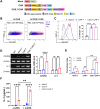
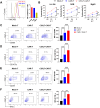
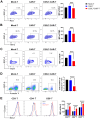
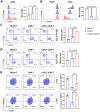


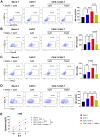
Similar articles
-
Enhanced homing and efficacy of HER2-CAR T cells via CXCR5/CCR6 co-expression for HER2-positive NSCLC.J Transl Med. 2025 Aug 5;23(1):863. doi: 10.1186/s12967-025-06866-9. J Transl Med. 2025. PMID: 40764989 Free PMC article.
-
Redirecting B7-H3.CAR T Cells to Chemokines Expressed in Osteosarcoma Enhances Homing and Antitumor Activity in Preclinical Models.Clin Cancer Res. 2024 Oct 1;30(19):4434-4449. doi: 10.1158/1078-0432.CCR-23-3298. Clin Cancer Res. 2024. PMID: 39101835 Free PMC article.
-
Anti-CD166/4-1BB chimeric antigen receptor T cell therapy for the treatment of osteosarcoma.J Exp Clin Cancer Res. 2019 Apr 17;38(1):168. doi: 10.1186/s13046-019-1147-6. J Exp Clin Cancer Res. 2019. PMID: 30995926 Free PMC article.
-
CAR T targets and microenvironmental barriers of osteosarcoma.Cytotherapy. 2022 Jun;24(6):567-576. doi: 10.1016/j.jcyt.2021.12.010. Epub 2022 Feb 19. Cytotherapy. 2022. PMID: 35193828 Review.
-
Treating osteosarcoma with CAR T cells.Scand J Immunol. 2019 Mar;89(3):e12741. doi: 10.1111/sji.12741. Epub 2019 Jan 15. Scand J Immunol. 2019. PMID: 30549299 Review.
Cited by
-
Advancements in Osteosarcoma Therapy: Overcoming Chemotherapy Resistance and Exploring Novel Pharmacological Strategies.Pharmaceuticals (Basel). 2025 Apr 3;18(4):520. doi: 10.3390/ph18040520. Pharmaceuticals (Basel). 2025. PMID: 40283955 Free PMC article. Review.
-
Advances in strategies to improve the immunotherapeutic efficacy of chimeric antigen receptor-T cell therapy for lymphoma.Cancer Biol Med. 2025 Apr 15;22(4):301-21. doi: 10.20892/j.issn.2095-3941.2024.0538. Cancer Biol Med. 2025. PMID: 40231980 Free PMC article. Review.
-
Osteosarcoma immune microenvironment: cellular struggle and novel therapeutic insights.Front Immunol. 2025 Jun 4;16:1584450. doi: 10.3389/fimmu.2025.1584450. eCollection 2025. Front Immunol. 2025. PMID: 40534850 Free PMC article. Review.
-
TCR-T cell therapy for solid tumors: challenges and emerging solutions.Front Pharmacol. 2025 Mar 10;16:1493346. doi: 10.3389/fphar.2025.1493346. eCollection 2025. Front Pharmacol. 2025. PMID: 40129944 Free PMC article. Review.
-
Emerging immunotherapies in osteosarcoma: from checkpoint blockade to cellular therapies.Front Immunol. 2025 Mar 18;16:1579822. doi: 10.3389/fimmu.2025.1579822. eCollection 2025. Front Immunol. 2025. PMID: 40170852 Free PMC article. Review.
References
MeSH terms
Substances
LinkOut - more resources
Full Text Sources
Medical
Research Materials
Miscellaneous

